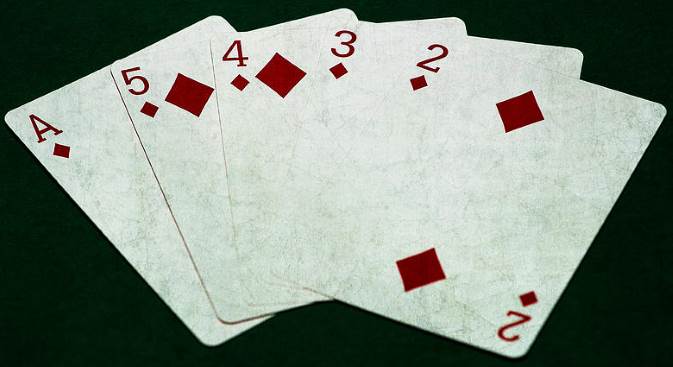
These graphs and tables show the bell curves for various numbers of dice vs. drawing the same number of cards from the 20-card deck. Most of these card bell curves match the d6 bell curve eerily well.
1d6 vs. 1-Card Bell Curve
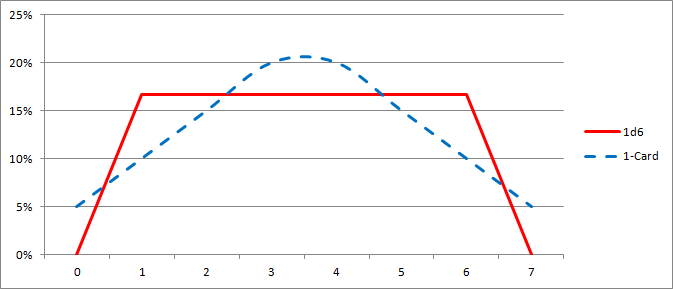
| Roll | 1d6 Freq | 1‑Card Freq | 1d6 % | 1‑Card % | 1d6 Cum% | 1‑Card Cum% | ||
|---|---|---|---|---|---|---|---|---|
| 0 | 0 | 1 | 0.00% | 5.00% | 0.00% | 5.00% | ||
| 1 | 1 | 2 | 16.67% | 10.00% | 16.67% | 15.00% | ||
| 2 | 1 | 3 | 16.67% | 15.00% | 33.33% | 30.00% | ||
| 3 | 1 | 4 | 16.67% | 20.00% | 50.00% | 50.00% | ||
| 4 | 1 | 4 | 16.67% | 20.00% | 66.67% | 70.00% | ||
| 5 | 1 | 3 | 16.67% | 15.00% | 83.33% | 85.00% | ||
| 6 | 1 | 2 | 16.67% | 10.00% | 100.00% | 95.00% | ||
| 7 | 0 | 1 | 0.00% | 5.00% | 100.00% | 100.00% | ||
| Total | 6 | 20 |
2d6 vs. 2‑Cards Bell Curve
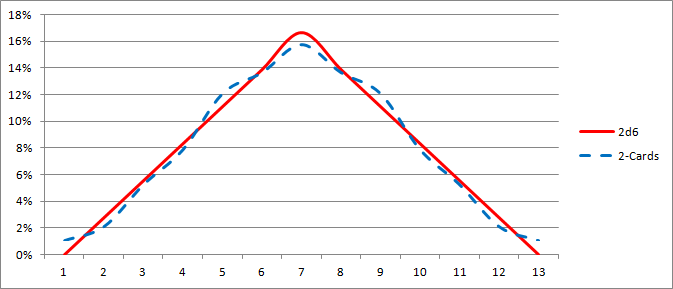
| Roll | 2d6 Freq | 2‑Card Freq | 2d6 % | 2‑Card % | 2d6 Cum% | 2‑Card Cum% | ||
|---|---|---|---|---|---|---|---|---|
| 1 | 0 | 4 | 0.00% | 1.05% | 0.00% | 1.05% | ||
| 2 | 1 | 8 | 2.78% | 2.11% | 2.78% | 3.16% | ||
| 3 | 2 | 20 | 5.56% | 5.26% | 8.33% | 8.42% | ||
| 4 | 3 | 30 | 8.33% | 7.89% | 16.67% | 16.32% | ||
| 5 | 4 | 46 | 11.11% | 12.11% | 27.78% | 28.42% | ||
| 6 | 5 | 52 | 13.89% | 13.68% | 41.67% | 42.11% | ||
| 7 | 6 | 60 | 16.67% | 15.79% | 58.33% | 57.89% | ||
| 8 | 5 | 52 | 13.89% | 13.68% | 72.22% | 71.58% | ||
| 9 | 4 | 46 | 11.11% | 12.11% | 83.33% | 83.68% | ||
| 10 | 3 | 30 | 8.33% | 7.89% | 91.67% | 91.58% | ||
| 11 | 2 | 20 | 5.56% | 5.26% | 97.22% | 96.84% | ||
| 12 | 1 | 8 | 2.78% | 2.11% | 100.00% | 98.95% | ||
| 13 | 0 | 4 | 0.00% | 1.05% | 100.00% | 100.00% | ||
| Total | 36 | 380 |
3d6 vs. 3‑Cards Bell Curve
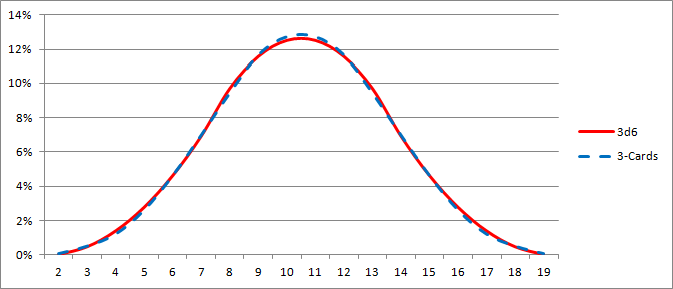
| Roll | 3d6 Freq | 3‑Card Freq | 3d6 % | 3‑Card % | 3d6 Cum% | 3‑Card Cum% | ||
|---|---|---|---|---|---|---|---|---|
| 2 | 0 | 6 | 0.00% | 0.09% | 0.00% | 0.09% | ||
| 3 | 1 | 36 | 0.46% | 0.53% | 0.46% | 0.61% | ||
| 4 | 3 | 84 | 1.39% | 1.23% | 1.85% | 1.84% | ||
| 5 | 6 | 180 | 2.78% | 2.63% | 4.63% | 4.47% | ||
| 6 | 10 | 318 | 4.63% | 4.65% | 9.26% | 9.12% | ||
| 7 | 15 | 480 | 6.94% | 7.02% | 16.20% | 16.14% | ||
| 8 | 21 | 648 | 9.72% | 9.47% | 25.93% | 25.61% | ||
| 9 | 25 | 798 | 11.57% | 11.67% | 37.50% | 37.28% | ||
| 10 | 27 | 870 | 12.50% | 12.72% | 50.00% | 50.00% | ||
| 11 | 27 | 870 | 12.50% | 12.72% | 62.50% | 62.72% | ||
| 12 | 25 | 798 | 11.57% | 11.67% | 74.07% | 74.39% | ||
| 13 | 21 | 648 | 9.72% | 9.47% | 83.80% | 83.86% | ||
| 14 | 15 | 480 | 6.94% | 7.02% | 90.74% | 90.88% | ||
| 15 | 10 | 318 | 4.63% | 4.65% | 95.37% | 95.53% | ||
| 16 | 6 | 180 | 2.78% | 2.63% | 98.15% | 98.16% | ||
| 17 | 3 | 84 | 1.39% | 1.23% | 99.54% | 99.39% | ||
| 18 | 1 | 36 | 0.46% | 0.53% | 100.00% | 99.91% | ||
| 19 | 0 | 6 | 0.00% | 0.09% | 100.00% | 100.00% | ||
| Total | 216 | 6,840 |
4d6 vs. 4‑Cards Bell Curve
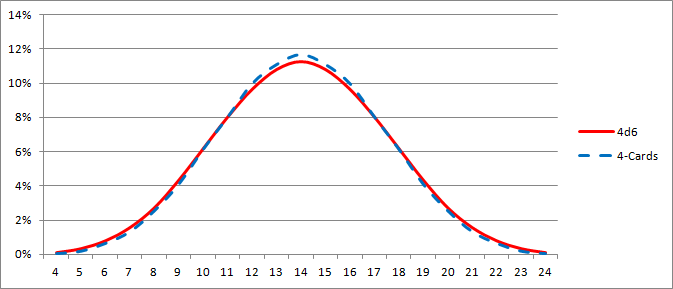
| Roll | 4d6 Freq | 4‑Card Freq | 4d6 % | 4‑Card % | 4d6 Cum% | 4‑Card Cum% | ||
|---|---|---|---|---|---|---|---|---|
| 4 | 1 | 72 | 0.08% | 0.06% | 0.08% | 0.06% | ||
| 5 | 4 | 240 | 0.31% | 0.21% | 0.39% | 0.27% | ||
| 6 | 10 | 768 | 0.77% | 0.66% | 1.16% | 0.93% | ||
| 7 | 20 | 1,560 | 1.54% | 1.34% | 2.70% | 2.27% | ||
| 8 | 35 | 2,976 | 2.70% | 2.56% | 5.40% | 4.83% | ||
| 9 | 56 | 4,776 | 4.32% | 4.11% | 9.72% | 8.94% | ||
| 10 | 80 | 7,152 | 6.17% | 6.15% | 15.90% | 15.09% | ||
| 11 | 104 | 9,336 | 8.02% | 8.03% | 23.92% | 23.12% | ||
| 12 | 125 | 11,592 | 9.65% | 9.97% | 33.56% | 33.09% | ||
| 13 | 140 | 12,888 | 10.80% | 11.08% | 44.37% | 44.17% | ||
| 14 | 146 | 13,560 | 11.27% | 11.66% | 55.63% | 55.83% | ||
| 15 | 140 | 12,888 | 10.80% | 11.08% | 66.44% | 66.91% | ||
| 16 | 125 | 11,592 | 9.65% | 9.97% | 76.08% | 76.88% | ||
| 17 | 104 | 9,336 | 8.02% | 8.03% | 84.10% | 84.91% | ||
| 18 | 80 | 7,152 | 6.17% | 6.15% | 90.28% | 91.06% | ||
| 19 | 56 | 4,776 | 4.32% | 4.11% | 94.60% | 95.17% | ||
| 20 | 35 | 2,976 | 2.70% | 2.56% | 97.30% | 97.73% | ||
| 21 | 20 | 1,560 | 1.54% | 1.34% | 98.84% | 99.07% | ||
| 22 | 10 | 768 | 0.77% | 0.66% | 99.61% | 99.73% | ||
| 23 | 4 | 240 | 0.31% | 0.21% | 99.92% | 99.94% | ||
| 24 | 1 | 72 | 0.08% | 0.06% | 100.00% | 100.00% | ||
| Total | 1,296 | 116,280 |
5d6 vs. 5‑Cards Bell Curve
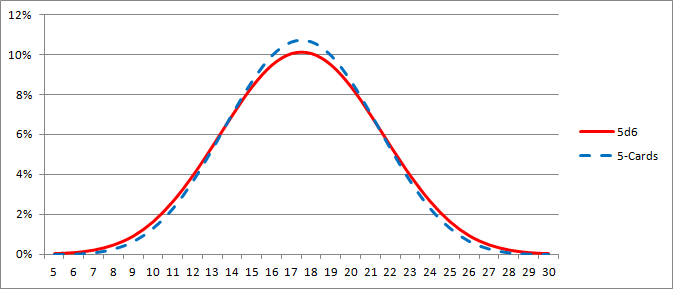
| Roll | 5d6 Freq | 5‑Card Freq | 5d6 % | 5‑Card % | 5d6 Cum% | 5‑Card Cum% | ||
|---|---|---|---|---|---|---|---|---|
| 5 | 1 | 0 | 0.01% | 0.00% | 0.01% | 0.00% | ||
| 6 | 5 | 360 | 0.06% | 0.02% | 0.08% | 0.02% | ||
| 7 | 15 | 1,680 | 0.19% | 0.09% | 0.27% | 0.11% | ||
| 8 | 35 | 5,160 | 0.45% | 0.28% | 0.72% | 0.39% | ||
| 9 | 70 | 12,120 | 0.90% | 0.65% | 1.62% | 1.04% | ||
| 10 | 126 | 24,720 | 1.62% | 1.33% | 3.24% | 2.37% | ||
| 11 | 205 | 43,080 | 2.64% | 2.32% | 5.88% | 4.68% | ||
| 12 | 305 | 68,400 | 3.92% | 3.68% | 9.80% | 8.36% | ||
| 13 | 420 | 98,640 | 5.40% | 5.30% | 15.20% | 13.66% | ||
| 14 | 540 | 131,160 | 6.94% | 7.05% | 22.15% | 20.71% | ||
| 15 | 651 | 161,520 | 8.37% | 8.68% | 30.52% | 29.39% | ||
| 16 | 735 | 185,280 | 9.45% | 9.96% | 39.97% | 39.35% | ||
| 17 | 780 | 198,120 | 10.03% | 10.65% | 50.00% | 50.00% | ||
| 18 | 780 | 198,120 | 10.03% | 10.65% | 60.03% | 60.65% | ||
| 19 | 735 | 185,280 | 9.45% | 9.96% | 69.48% | 70.61% | ||
| 20 | 651 | 161,520 | 8.37% | 8.68% | 77.85% | 79.29% | ||
| 21 | 540 | 131,160 | 6.94% | 7.05% | 84.80% | 86.34% | ||
| 22 | 420 | 98,640 | 5.40% | 5.30% | 90.20% | 91.64% | ||
| 23 | 305 | 68,400 | 3.92% | 3.68% | 94.12% | 95.32% | ||
| 24 | 205 | 43,080 | 2.64% | 2.32% | 96.76% | 97.63% | ||
| 25 | 126 | 24,720 | 1.62% | 1.33% | 98.38% | 98.96% | ||
| 26 | 70 | 12,120 | 0.90% | 0.65% | 99.28% | 99.61% | ||
| 27 | 35 | 5,160 | 0.45% | 0.28% | 99.73% | 99.89% | ||
| 28 | 15 | 1,680 | 0.19% | 0.09% | 99.92% | 99.98% | ||
| 29 | 5 | 360 | 0.06% | 0.02% | 99.99% | 100.00% | ||
| 30 | 1 | 0 | 0.01% | 0.00% | 100.00% | 100.00% | ||
| Total | 7,776 | 1,860,480 |
6d6 vs. 6‑Cards Bell Curve

| Roll | 6d6 Freq | 6‑Card Freq | 6d6% | 6‑Card % | 6d6 Cum% | 6‑Card Cum% | ||
|---|---|---|---|---|---|---|---|---|
| 6 | 1 | 0 | 0.002% | 0.000% | 0.002% | 0.000% | ||
| 7 | 6 | 0 | 0.013% | 0.000% | 0.015% | 0.000% | ||
| 8 | 21 | 720 | 0.045% | 0.003% | 0.060% | 0.003% | ||
| 9 | 56 | 8,640 | 0.120% | 0.031% | 0.180% | 0.034% | ||
| 10 | 126 | 27,360 | 0.270% | 0.098% | 0.450% | 0.132% | ||
| 11 | 252 | 78,480 | 0.540% | 0.281% | 0.990% | 0.413% | ||
| 12 | 456 | 171,360 | 0.977% | 0.614% | 1.968% | 1.027% | ||
| 13 | 756 | 335,520 | 1.620% | 1.202% | 3.588% | 2.229% | ||
| 14 | 1,161 | 570,960 | 2.488% | 2.046% | 6.076% | 4.275% | ||
| 15 | 1,666 | 903,600 | 3.571% | 3.238% | 9.647% | 7.513% | ||
| 16 | 2,247 | 1,289,520 | 4.816% | 4.621% | 14.463% | 12.134% | ||
| 17 | 2,856 | 1,732,320 | 6.121% | 6.207% | 20.585% | 18.341% | ||
| 18 | 3,431 | 2,148,480 | 7.354% | 7.699% | 27.939% | 26.040% | ||
| 19 | 3,906 | 2,517,120 | 8.372% | 9.020% | 36.310% | 35.059% | ||
| 20 | 4,221 | 2,746,800 | 9.047% | 9.843% | 45.358% | 44.902% | ||
| 21 | 4,332 | 2,845,440 | 9.285% | 10.196% | 54.642% | 55.098% | ||
| 22 | 4,221 | 2,746,800 | 9.047% | 9.843% | 63.690% | 64.941% | ||
| 23 | 3,906 | 2,517,120 | 8.372% | 9.020% | 72.061% | 73.960% | ||
| 24 | 3,431 | 2,148,480 | 7.354% | 7.699% | 79.415% | 81.659% | ||
| 25 | 2,856 | 1,732,320 | 6.121% | 6.207% | 85.537% | 87.866% | ||
| 26 | 2,247 | 1,289,520 | 4.816% | 4.621% | 90.353% | 92.487% | ||
| 27 | 1,666 | 903,600 | 3.571% | 3.238% | 93.924% | 95.725% | ||
| 28 | 1,161 | 570,960 | 2.488% | 2.046% | 96.412% | 97.771% | ||
| 29 | 756 | 335,520 | 1.620% | 1.202% | 98.032% | 98.973% | ||
| 30 | 456 | 171,360 | 0.977% | 0.614% | 99.010% | 99.587% | ||
| 31 | 252 | 78,480 | 0.540% | 0.281% | 99.550% | 99.868% | ||
| 32 | 126 | 27,360 | 0.270% | 0.098% | 99.820% | 99.966% | ||
| 33 | 56 | 8640 | 0.120% | 0.031% | 99.940% | 99.997% | ||
| 34 | 21 | 720 | 0.045% | 0.003% | 99.985% | 100.000% | ||
| 35 | 6 | 0 | 0.013% | 0.000% | 99.998% | 100.000% | ||
| 36 | 1 | 0 | 0.002% | 0.000% | 100.000% | 100.000% | ||
| Total | 46,656 | 27,907,200 |
7d6 vs. 7‑Cards Bell Curve
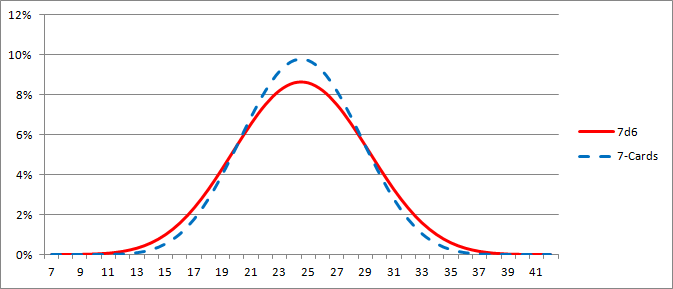
| Roll | 7d6 Freq | 7‑Card Freq | 7d6% | 7‑Card % | 7d6 Cum% | 7‑Card Cum% | ||
|---|---|---|---|---|---|---|---|---|
| 7 | 1 | 0 | 0.0004% | 0.0000% | 0.0004% | 0.0000% | ||
| 8 | 7 | 0 | 0.0025% | 0.0000% | 0.0029% | 0.0000% | ||
| 9 | 28 | 0 | 0.0100% | 0.0000% | 0.0129% | 0.0000% | ||
| 10 | 84 | 0 | 0.0300% | 0.0000% | 0.0429% | 0.0000% | ||
| 11 | 210 | 20,160 | 0.0750% | 0.0052% | 0.1179% | 0.0052% | ||
| 12 | 462 | 110,880 | 0.1650% | 0.0284% | 0.2829% | 0.0335% | ||
| 13 | 917 | 378,000 | 0.3276% | 0.0967% | 0.6105% | 0.1303% | ||
| 14 | 1,667 | 962,640 | 0.5955% | 0.2464% | 1.2060% | 0.3767% | ||
| 15 | 2,807 | 2,121,840 | 1.0027% | 0.5431% | 2.2087% | 0.9198% | ||
| 16 | 4,417 | 4,037,040 | 1.5779% | 1.0333% | 3.7866% | 1.9530% | ||
| 17 | 6,538 | 6,945,120 | 2.3355% | 1.7776% | 6.1221% | 3.7307% | ||
| 18 | 9,142 | 10,891,440 | 3.2657% | 2.7877% | 9.3879% | 6.5183% | ||
| 19 | 12,117 | 15,800,400 | 4.3285% | 4.0441% | 13.7163% | 10.5624% | ||
| 20 | 15,267 | 21,299,040 | 5.4537% | 5.4515% | 19.1701% | 16.0139% | ||
| 21 | 18,327 | 26,948,880 | 6.5469% | 6.8976% | 25.7169% | 22.9115% | ||
| 22 | 20,993 | 32,014,080 | 7.4992% | 8.1940% | 33.2162% | 31.1055% | ||
| 23 | 22,967 | 35,864,640 | 8.2044% | 9.1796% | 41.4205% | 40.2851% | ||
| 24 | 24,017 | 37,956,240 | 8.5795% | 9.7149% | 50.0000% | 50.0000% | ||
| 25 | 24,017 | 37,956,240 | 8.5795% | 9.7149% | 58.5795% | 59.7149% | ||
| 26 | 22,967 | 35,864,640 | 8.2044% | 9.1796% | 66.7838% | 68.8945% | ||
| 27 | 20,993 | 32,014,080 | 7.4992% | 8.1940% | 74.2831% | 77.0885% | ||
| 28 | 18,327 | 26,948,880 | 6.5469% | 6.8976% | 80.8299% | 83.9861% | ||
| 29 | 15,267 | 21,299,040 | 5.4537% | 5.4515% | 86.2837% | 89.4376% | ||
| 30 | 12,117 | 15,800,400 | 4.3285% | 4.0441% | 90.6121% | 93.4817% | ||
| 31 | 9,142 | 10,891,440 | 3.2657% | 2.7877% | 93.8779% | 96.2693% | ||
| 32 | 6,538 | 6,945,120 | 2.3355% | 1.7776% | 96.2134% | 98.0470% | ||
| 33 | 4,417 | 4,037,040 | 1.5779% | 1.0333% | 97.7913% | 99.0802% | ||
| 34 | 2,807 | 2,121,840 | 1.0027% | 0.5431% | 98.7940% | 99.6233% | ||
| 35 | 1,667 | 962,640 | 0.5955% | 0.2464% | 99.3895% | 99.8697% | ||
| 36 | 917 | 378,000 | 0.3276% | 0.0967% | 99.7171% | 99.9665% | ||
| 37 | 462 | 110,880 | 0.1650% | 0.0284% | 99.8821% | 99.9948% | ||
| 38 | 210 | 20,160 | 0.0750% | 0.0052% | 99.9571% | 100.0000% | ||
| 39 | 84 | 0 | 0.0300% | 0.0000% | 99.9871% | 100.0000% | ||
| 40 | 28 | 0 | 0.0100% | 0.0000% | 99.9971% | 100.0000% | ||
| 41 | 7 | 0 | 0.0025% | 0.0000% | 99.9996% | 100.0000% | ||
| 42 | 1 | 0 | 0.0004% | 0.0000% | 100.0000% | 100.0000% | ||
| Total | 279,936 | 390,700,800 |
8d6 vs. 8‑Cards Bell Curve
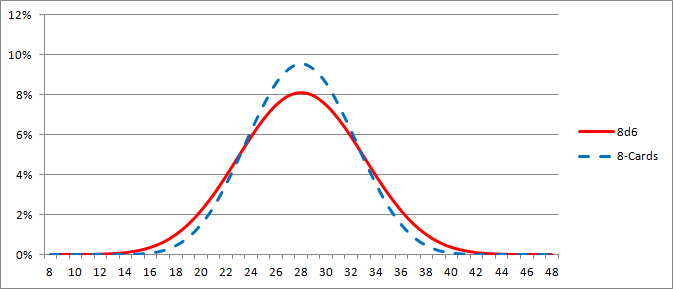
| Roll | 8d6 Freq | 8‑Card Freq | 8d6% | 8‑Card % | 8d6 Cum% | 8‑Card Cum% | ||
|---|---|---|---|---|---|---|---|---|
| 8 | 1 | 0 | 0.0001% | 0.0000% | 0.0001% | 0.0000% | ||
| 9 | 8 | 0 | 0.0005% | 0.0000% | 0.0005% | 0.0000% | ||
| 10 | 36 | 0 | 0.0021% | 0.0000% | 0.0027% | 0.0000% | ||
| 11 | 120 | 0 | 0.0071% | 0.0000% | 0.0098% | 0.0000% | ||
| 12 | 330 | 0 | 0.0196% | 0.0000% | 0.0295% | 0.0000% | ||
| 13 | 792 | 0 | 0.0472% | 0.0000% | 0.0766% | 0.0000% | ||
| 14 | 1,708 | 241,920 | 0.1017% | 0.0048% | 0.1783% | 0.0048% | ||
| 15 | 3,368 | 1,128,960 | 0.2005% | 0.0222% | 0.3788% | 0.0270% | ||
| 16 | 6,147 | 4,072,320 | 0.3660% | 0.0802% | 0.7448% | 0.1072% | ||
| 17 | 10,480 | 10,160,640 | 0.6240% | 0.2000% | 1.3688% | 0.3072% | ||
| 18 | 16,808 | 22,700,160 | 1.0007% | 0.4469% | 2.3695% | 0.7541% | ||
| 19 | 25,488 | 43,424,640 | 1.5175% | 0.8550% | 3.8870% | 1.6091% | ||
| 20 | 36,688 | 76,003,200 | 2.1843% | 1.4964% | 6.0713% | 3.1055% | ||
| 21 | 50,288 | 120,153,600 | 2.9940% | 2.3656% | 9.0653% | 5.4711% | ||
| 22 | 65,808 | 177,649,920 | 3.9180% | 3.4977% | 12.9833% | 8.9688% | ||
| 23 | 82,384 | 242,847,360 | 4.9049% | 4.7813% | 17.8883% | 13.7501% | ||
| 24 | 98,813 | 313,608,960 | 5.8831% | 6.1745% | 23.7713% | 19.9246% | ||
| 25 | 113,688 | 379,209,600 | 6.7687% | 7.4661% | 30.5400% | 27.3906% | ||
| 26 | 125,588 | 435,254,400 | 7.4772% | 8.5695% | 38.0172% | 35.9601% | ||
| 27 | 133,288 | 470,736,000 | 7.9356% | 9.2681% | 45.9528% | 45.2282% | ||
| 28 | 135,954 | 484,727,040 | 8.0944% | 9.5435% | 54.0472% | 54.7718% | ||
| 29 | 133,288 | 470,736,000 | 7.9356% | 9.2681% | 61.9828% | 64.0399% | ||
| 30 | 125,588 | 435,254,400 | 7.4772% | 8.5695% | 69.4600% | 72.6094% | ||
| 31 | 113,688 | 379,209,600 | 6.7687% | 7.4661% | 76.2287% | 80.0754% | ||
| 32 | 98,813 | 313,608,960 | 5.8831% | 6.1745% | 82.1117% | 86.2499% | ||
| 33 | 82,384 | 242,847,360 | 4.9049% | 4.7813% | 87.0167% | 91.0312% | ||
| 34 | 65,808 | 177,649,920 | 3.9180% | 3.4977% | 90.9347% | 94.5289% | ||
| 35 | 50,288 | 120,153,600 | 2.9940% | 2.3656% | 93.9287% | 96.8945% | ||
| 36 | 36,688 | 76,003,200 | 2.1843% | 1.4964% | 96.1130% | 98.3909% | ||
| 37 | 25,488 | 43,424,640 | 1.5175% | 0.8550% | 97.6305% | 99.2459% | ||
| 38 | 16,808 | 22,700,160 | 1.0007% | 0.4469% | 98.6312% | 99.6928% | ||
| 39 | 10,480 | 10,160,640 | 0.6240% | 0.2000% | 99.2552% | 99.8928% | ||
| 40 | 6,147 | 4,072,320 | 0.3660% | 0.0802% | 99.6212% | 99.9730% | ||
| 41 | 3,368 | 1,128,960 | 0.2005% | 0.0222% | 99.8217% | 99.9952% | ||
| 42 | 1,708 | 241,920 | 0.1017% | 0.0048% | 99.9234% | 100.0000% | ||
| 43 | 792 | 0 | 0.0472% | 0.0000% | 99.9705% | 100.0000% | ||
| 44 | 330 | 0 | 0.0196% | 0.0000% | 99.9902% | 100.0000% | ||
| 45 | 120 | 0 | 0.0071% | 0.0000% | 99.9973% | 100.0000% | ||
| 46 | 36 | 0 | 0.0021% | 0.0000% | 99.9995% | 100.0000% | ||
| 47 | 8 | 0 | 0.0005% | 0.0000% | 99.9999% | 100.0000% | ||
| 48 | 1 | 0 | 0.0001% | 0.0000% | 100.0000% | 100.0000% | ||
| Total | 1,679,616 | 5,079,110,400 |
9d6 vs. 9‑Cards Bell Curve
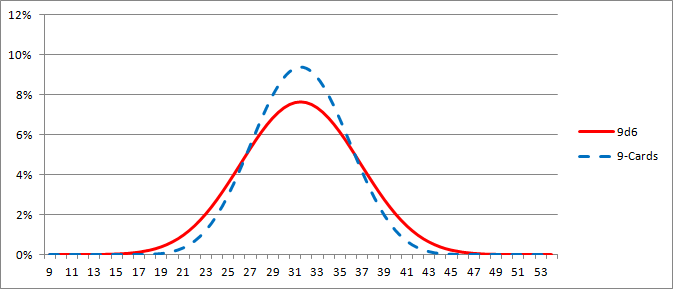
| Roll | 9d6 Freq | 9‑Card Freq | 9d6% | 9‑Card % | 9d6 Cum% | 9‑Card Cum% |
||
|---|---|---|---|---|---|---|---|---|
| 9 | 1 | 0 | 0.00001% | 0.00000% | 0.00001% | 0.00000% | ||
| 10 | 9 | 0 | 0.00009% | 0.00000% | 0.00010% | 0.00000% | ||
| 11 | 45 | 0 | 0.00045% | 0.00000% | 0.00055% | 0.00000% | ||
| 12 | 165 | 0 | 0.00164% | 0.00000% | 0.00218% | 0.00000% | ||
| 13 | 495 | 0 | 0.00491% | 0.00000% | 0.00709% | 0.00000% | ||
| 14 | 1,287 | 0 | 0.01277% | 0.00000% | 0.01987% | 0.00000% | ||
| 15 | 2,994 | 0 | 0.02971% | 0.00000% | 0.04957% | 0.00000% | ||
| 16 | 6,354 | 0 | 0.06305% | 0.00000% | 0.11262% | 0.00000% | ||
| 17 | 12,465 | 1,451,520 | 0.12369% | 0.00238% | 0.23631% | 0.00238% | ||
| 18 | 22,825 | 9,797,760 | 0.22649% | 0.01608% | 0.46280% | 0.01846% | ||
| 19 | 39,303 | 33,384,960 | 0.39000% | 0.05477% | 0.85280% | 0.07323% | ||
| 20 | 63,999 | 91,808,640 | 0.63506% | 0.15063% | 1.48786% | 0.22386% | ||
| 21 | 98,979 | 207,930,240 | 0.98216% | 0.34115% | 2.47002% | 0.56502% | ||
| 22 | 145,899 | 413,320,320 | 1.44774% | 0.67814% | 3.91776% | 1.24315% | ||
| 23 | 205,560 | 735,920,640 | 2.03975% | 1.20743% | 5.95751% | 2.45058% | ||
| 24 | 277,464 | 1,201,858,560 | 2.75325% | 1.97190% | 8.71076% | 4.42248% | ||
| 25 | 359,469 | 1,807,505,280 | 3.56698% | 2.96559% | 12.27774% | 7.38807% | ||
| 26 | 447,669 | 2,539,434,240 | 4.44218% | 4.16647% | 16.71991% | 11.55454% | ||
| 27 | 536,569 | 3,342,850,560 | 5.32432% | 5.48464% | 22.04424% | 17.03918% | ||
| 28 | 619,569 | 4,146,629,760 | 6.14792% | 6.80341% | 28.19216% | 23.84258% | ||
| 29 | 689,715 | 4,859,688,960 | 6.84398% | 7.97333% | 35.03613% | 31.81591% | ||
| 30 | 740,619 | 5,398,202,880 | 7.34909% | 8.85687% | 42.38522% | 40.67278% | ||
| 31 | 767,394 | 5,684,878,080 | 7.61478% | 9.32722% | 50.00000% | 50.00000% | ||
| 32 | 767,394 | 5,684,878,080 | 7.61478% | 9.32722% | 57.61478% | 59.32722% | ||
| 33 | 740,619 | 5,398,202,880 | 7.34909% | 8.85687% | 64.96387% | 68.18409% | ||
| 34 | 689,715 | 4,859,688,960 | 6.84398% | 7.97333% | 71.80784% | 76.15742% | ||
| 35 | 619,569 | 4,146,629,760 | 6.14792% | 6.80341% | 77.95576% | 82.96082% | ||
| 36 | 536,569 | 3,342,850,560 | 5.32432% | 5.48464% | 83.28009% | 88.44546% | ||
| 37 | 447,669 | 2,539,434,240 | 4.44218% | 4.16647% | 87.72226% | 92.61193% | ||
| 38 | 359,469 | 1,807,505,280 | 3.56698% | 2.96559% | 91.28924% | 95.57752% | ||
| 39 | 277,464 | 1,201,858,560 | 2.75325% | 1.97190% | 94.04249% | 97.54942% | ||
| 40 | 205,560 | 735,920,640 | 2.03975% | 1.20743% | 96.08224% | 98.75685% | ||
| 41 | 145,899 | 413,320,320 | 1.44774% | 0.67814% | 97.52998% | 99.43498% | ||
| 42 | 98,979 | 207,930,240 | 0.98216% | 0.34115% | 98.51214% | 99.77613% | ||
| 43 | 63,999 | 91,808,640 | 0.63506% | 0.15063% | 99.14720% | 99.92676% | ||
| 44 | 39,303 | 33,384,960 | 0.39000% | 0.05477% | 99.53720% | 99.98153% | ||
| 45 | 22,825 | 9,797,760 | 0.22649% | 0.01608% | 99.76369% | 99.99762% | ||
| 46 | 12,465 | 1,451,520 | 0.12369% | 0.00238% | 99.88738% | 100.00000% | ||
| 47 | 6,354 | 0 | 0.06305% | 0.00000% | 99.95043% | 100.00000% | ||
| 48 | 2,994 | 0 | 0.02971% | 0.00000% | 99.98013% | 100.00000% | ||
| 49 | 1,287 | 0 | 0.01277% | 0.00000% | 99.99290% | 100.00000% | ||
| 50 | 495 | 0 | 0.00491% | 0.00000% | 99.99781% | 100.00000% | ||
| 51 | 165 | 0 | 0.00164% | 0.00000% | 99.99945% | 100.00000% | ||
| 52 | 45 | 0 | 0.00045% | 0.00000% | 99.99990% | 100.00000% | ||
| 53 | 9 | 0 | 0.00009% | 0.00000% | 99.99999% | 100.00000% | ||
| 54 | 1 | 0 | 0.00001% | 0.00000% | 100.00000% | 100.00000% | ||
| Total | 10,077,696 | 60,949,324,800 |
10d6 vs. 10‑Cards Bell Curve
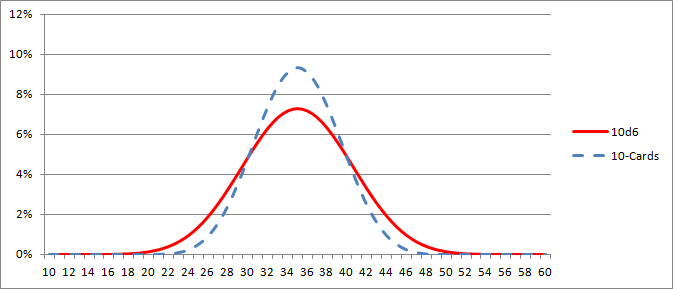
11d6 vs. 11‑Cards Bell Curve
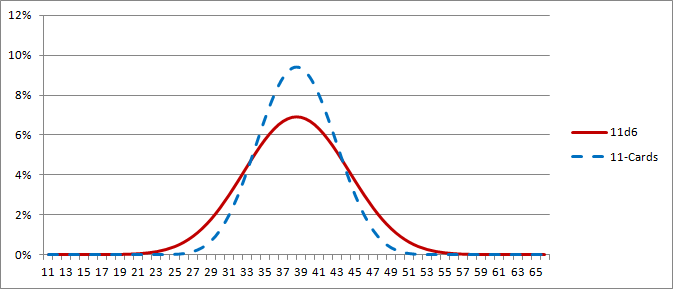
12d6 vs. 12‑Cards Bell Curve

Copyright © 2018 Eric B. Smith